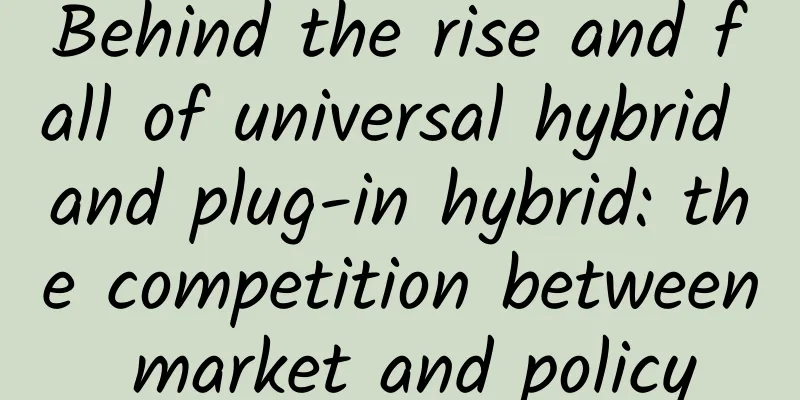Behind the rise and fall of universal hybrid and plug-in hybrid: the competition between market and policy

|
Recently, the sales data of new energy vehicles were released, and a subtle change attracted the attention of the industry, that is, the sales of ordinary oil-electric hybrid models exceeded that of plug-in hybrid vehicles by a large margin for the first time . At a time when the newly released "Technology Roadmap for Energy-Saving and New Energy Vehicles" has elevated hybrid technology to a new strategic level, the ordinary hybrid models chosen by consumers with real money have surpassed the plug-in hybrid models "designated" for promotion by policy. This may seem like a coincidence, but upon closer analysis, it has important warning and predictive significance for the future development of the energy-saving and new energy vehicle industry that is worthy of deep thought. New energy growth slows down, and conventional hybrids surpass plug-in hybrids Previously, the National Passenger Car Market Information Joint Conference announced the passenger car market sales in October this year. The data showed that the sales of new energy passenger cars in October were 30,900 units, a month-on-month increase of 4% and a year-on-year increase of 52%, a significant decrease from the 65% in September; among them, the sales of plug-in hybrid vehicles were 4,178 units, a year-on-year decrease of 31% and a month-on-month decrease of 44%; the sales of pure electric vehicles were 26,800 units, a year-on-year increase of 87% and a month-on-month increase of 20%. Data released by the China Association of Automobile Manufacturers recently showed that my country's automobile sales in October were 2.6499 million units, a month-on-month increase of 3.35% and a year-on-year increase of 18.65%; among them, passenger car sales were 2.3441 million units, a month-on-month increase of 3.34% and a year-on-year increase of 20.29%. In other words, although the year-on-year and month-on-month growth rates of new energy passenger vehicles in October were still higher than the overall level of the automobile market and the passenger car market, compared with the continued high growth in the previous two years and even the first half of this year, the current 4% month-on-month growth and 52% year-on-year growth are already at a medium-to-low level. Moreover, since June this year, monthly sales have remained at around 30,000 vehicles for five consecutive months. Both products and the market have entered a stage of adjustment and accumulation of momentum. It is worth noting that in the process of slowing down the overall growth of new energy passenger vehicles, plug-in hybrid vehicles, whose sales have fallen sharply both year-on-year and month-on-month, can be called the "culprit". In sharp contrast, the sales of ordinary hybrid models have been rising steadily recently, and in October, they showed a good momentum of full bloom, with sales reaching 7,065 units, far exceeding the 4,178 units of plug-in hybrid vehicles, which is nearly 70% higher than the latter. As we all know, in a series of documents such as the "Energy-Saving and New Energy Vehicle Industry Development Plan (2012-2020)" and the "Guiding Opinions on Accelerating the Promotion and Application of New Energy Vehicles", according to my country's official definition of new energy vehicles, ordinary hybrid models are energy-saving vehicles rather than new energy vehicles. This also means that ordinary hybrid models have less policy benefits and support than plug-in hybrid vehicles, and are in a relatively weak position in market competition. However, after several years of promoting new energy vehicles, the plug-in hybrid models that developed rapidly in the early stage are now lacking momentum, while the ordinary hybrid models that were not favored by the policy before have been rising all the way, and achieved a "reversal" in October. The meaning behind this phenomenon of deviation between the market choice "voted" by consumers with real money and the promotion "determined" by the policy is worth deep thinking. The sales volume of general mixed products is rising steadily. The "competition" between the market and policies In fact, since the beginning of the promotion of new energy vehicles, there has been a call in the industry for policy support and subsidy benefits for ordinary hybrid models. Ye Shengji, deputy secretary-general of the China Association of Automobile Manufacturers, once publicly stated that "while accelerating the industrialization of new energy vehicles, it is necessary to continue to encourage and promote the development of various energy-saving vehicles, including hybrid vehicles, and we must not lose sight of one while focusing on the other." However, in order to ensure the competitiveness of new energy vehicles, and taking all aspects into consideration, the national strategy for developing new energy vehicles is still mainly oriented towards pure electric drive, focusing on the development of pure electric vehicles , plug-in hybrid vehicles and fuel cell vehicles . It is precisely because of the choice of national strategy that ordinary hybrid vehicles, which have no policy support, are more complex in technology and more expensive, have been wandering on the edge of the domestic market. The sales volume of domestic hybrid models in 2015 was only about 13,000 units. According to the statistics of China Passenger Car Association, the cumulative sales of hybrid models in China from January to October this year has reached 62,700 units, a very rapid growth. Ordinary hybrid models have suddenly entered the fast lane, and it should be said that Japanese companies such as Toyota and Honda have made great contributions to this. From Toyota's earliest Prius and Camry hybrids, to the later Levin Hybrid and Corolla Hybrid, to Honda's flagship model Accord Hybrid that was launched not long ago, Japanese brands have driven the sales of hybrid models to rise all the way. In particular, after Toyota strengthened its localization strategy in China, it launched the Corolla Hybrid and the Corolla Hybrid, which lowered the price of ordinary hybrid models to less than 150,000 yuan, and had a price advantage in competing with traditional fuel compact models. The Prius, which was a big seller in North America but had a relatively high price in the early days, successfully transformed the "cold" image of hybrid models with high prices that were brought to Chinese consumers into a "down-to-earth" civilian model that is easy to use, fuel-efficient, and cost-effective. At present, Toyota is still the main force of hybrid models in China. The average monthly sales of Corolla Hybrid and Levin Hybrid are stable at about 3,500 and 2,000 respectively, and Camry Hybrid also maintains a monthly sales of about 500. After Toyota has cultivated a certain consumer group and reputation for hybrid models, more and more car companies have joined this market segment. For example, Honda directly launched the Accord Hybrid as its flagship model in the domestic market. Since its launch in September, its sales have been catching up with Camry Hybrid. In addition, the Dongfeng Yueda Kia K5 Hybrid and Beijing Hyundai's first new energy mass-produced car, the ninth-generation Sonata Hybrid, which were launched in June, the Dongfeng Nissan Luqi Hybrid and the SAIC General Motors Buick LaCrosse 30H full hybrid, which were launched in August, have launched a full range of models, and the hybrid trend of mid-to-high-end cars is becoming increasingly obvious. In contrast, current sales of plug-in hybrid vehicles are mainly concentrated in cities with purchase restrictions, such as Shanghai. They have not been able to penetrate Beijing, which "only recognizes" pure electric vehicles, and have also performed mediocrely in Guangzhou and Shenzhen. For example, BYD Qin's cumulative sales in the first three quarters of this year have fallen by 30% year-on-year. Models such as BYD Tang, SAIC Roewe 550 Plug-in, and GAC Trumpchi GA5 PHEV have also seen a significant decline in sales recently. While ordinary hybrid vehicles and plug-in hybrid vehicles have formed a relatively obvious direct competitive relationship, the two are almost growing while their counterparts decline. In a sense, this can be described as a "contest" between the market and policy. Technology roadmap released, hybrid power status enhanced To be fair, in the Chinese market where environmental awareness has yet to be improved, ordinary hybrid models that have experienced severe competition can gradually gain recognition from more and more consumers, which is enough to prove that hybrid technology has great potential in China. This voice from the market has also been heard by the industry and the government, and is reflected in the country's industrial strategic planning. On October 26, at the annual meeting of the Society of Automotive Engineers of China, the "Energy-saving and New Energy Vehicle Technology Roadmap", which took 500 industry experts a year to complete, was officially released to the public, outlining the technology development blueprint for China's automotive industry in the next 15 years. The roadmap released this time is "1+7", mainly including: overall technology roadmap, energy-saving vehicle technology roadmap , pure electric and plug-in hybrid vehicle technology roadmap, hydrogen fuel cell vehicle technology roadmap, intelligent networked vehicle technology roadmap, automobile manufacturing technology roadmap, automobile power battery technology roadmap, and automobile lightweight technology roadmap. That is to say, in terms of development direction and path selection, the technology roadmap takes energy-saving vehicles, new energy vehicles and intelligent networked vehicles as the main breakthroughs, and comprehensively promotes the low-carbonization, informationization, intelligence and high quality of the automobile industry. In the past policy documents and national strategies, energy-saving vehicles appeared as a "foil" of new energy vehicles to some extent, but this "Energy-saving and New Energy Vehicle Technology Roadmap" has raised energy-saving vehicles, especially hybrid vehicles, to a new level. In fact, Made in China 2025 has clearly listed energy-saving and new energy vehicles as one of the ten key development areas, and the Energy-saving and New Energy Vehicle Technology Roadmap further proposed detailed goals: by 2030, the sales of new energy vehicles will account for 40% of the total vehicle sales, and the fuel consumption of new passenger cars will reach 3.2 liters per 100 kilometers in 2030; in addition, vigorously developing oil-electric hybrid vehicles has become a "hard indicator" for the first time. According to the plan, the sales share of hybrid models will reach 8% in 2020 and increase to 25% in 2030. "We were biased in the past. We were all working on new energy, but new energy vehicles cannot occupy a dominant position at the current level." Fu Yuwu, the operator of the technology roadmap and chairman of the China Society of Automotive Engineers, pointed out more clearly, "There is no doubt that hybrid power will attract unprecedented attention because the regulations are there and this technology is the most mature. For example, hybrid power can save 5% of oil, which is very important. If we don't do these basic technologies well, electric vehicles will not be sold abroad on a large scale." In his opinion, traditional cars will still dominate the Chinese auto market by 2030, and the sales of new energy and energy-saving cars by then "should mainly be hybrid", including mild hybrid, micro hybrid, medium hybrid to deep hybrid. His confidence in this judgment comes from the pressure and motivation brought to enterprises and the market by the implementation of regulations such as the points system and the fourth stage of passenger car fuel consumption standards. Fuel consumption target is high, pure electric and hybrid vehicles develop together Ouyang Minggao, a member of the National Power Strategy Advisory Committee and a professor at Tsinghua University, also clearly pointed out that "Regarding energy-saving vehicles, the overall idea is to focus on hybrid power, supported by powertrain upgrades and advanced electronic appliances, and comprehensively improve the energy-saving technology and fuel economy level of traditional fuel vehicles." The "Technology Roadmap for Key Areas of Made in China 2025 (2015 Edition)" released by the Ministry of Industry and Information Technology in October last year pointed out that the annual sales of new energy vehicles in China should reach more than 5% of the total demand in the automobile market in 2020, but the "Technology Roadmap for Energy-Saving and New Energy Vehicles" pointed out that "by 2020, the sales of new energy vehicles will account for more than 7% of the total sales of automobiles". At the same time, according to the technology roadmap, the sales of hybrid vehicles will account for 8% in 2020, with a fuel consumption of 4 liters per 100 kilometers; in 2025, it will increase to 20%, with a fuel consumption of 3.6 liters per 100 kilometers; in 2030, it will increase to 25%, with a fuel consumption of 3.3 liters per 100 kilometers. At present, it seems that it may not be difficult for Japanese automakers led by Toyota to meet the above standards: in the first nine months of this year, FAW Toyota's Corolla Hybrid accounted for 6.8% of its overall sales, and GAC Toyota's Levin Hybrid and Camry Hybrid accounted for 7.3% of its overall sales; but some other automakers do not have rich products in the hybrid field, so it will be difficult for the industry's sales to reach 8% in 2020, or 2.1 million vehicles. Regarding the current situation where domestic automakers are lagging behind in hybrid technology development and have few products, Yin Chengliang, director of the Institute of Automotive Energy Saving Technology of Shanghai Jiao Tong University, bluntly stated that the complexity of hybrid technology is much higher than that of pure electric and plug-in hybrid technology. "The difficulty of hybrid technology ultimately comes down to traditional engine and transmission technology. In these two areas, technological breakthroughs are extremely difficult, and domestic brands are relatively backward." In addition, due to the past policy bias towards new energy vehicles, domestic automakers also lack enthusiasm for the research and development of hybrid vehicles , and their investment is relatively low. However, it is worth noting that more and more automakers are increasing their investment in the hybrid market segment. At the upcoming Guangzhou Auto Show this year, in addition to the debut of the Dongfeng Honda Spirior hybrid model equipped with the i-MMD dual-motor hybrid system, the DS6 hybrid version, the Han Teng X7 hybrid version, and the fifth-generation Land Rover Discovery will also have hybrid models on display; at the same time, SAIC Roewe eRX5, Audi A6Le-tron, Cadillac CT6, Volvo S90, MINI COUNTRY MAN, Changan Ford New Mondeo, Borgward BX5, Great Wall Haval, SAIC Volkswagen Teramont, Mercedes-Benz GLCCouple, GAC Trumpchi, etc. will also launch plug-in hybrid models. As Fu Yuwu said, the significance of the release of the "Technology Roadmap for Energy-Saving and New Energy Vehicles" lies in preventing the development of the automobile industry from "going astray" through "multiple means". Under the joint influence of policy guidance, market choice and corporate investment, energy-saving and new energy vehicles in the future will embark on a path of giving equal importance to pure electric and hybrid, and developing along multiple routes. As a winner of Toutiao's Qingyun Plan and Baijiahao's Bai+ Plan, the 2019 Baidu Digital Author of the Year, the Baijiahao's Most Popular Author in the Technology Field, the 2019 Sogou Technology and Culture Author, and the 2021 Baijiahao Quarterly Influential Creator, he has won many awards, including the 2013 Sohu Best Industry Media Person, the 2015 China New Media Entrepreneurship Competition Beijing Third Place, the 2015 Guangmang Experience Award, the 2015 China New Media Entrepreneurship Competition Finals Third Place, and the 2018 Baidu Dynamic Annual Powerful Celebrity. |
>>: The outcome of the competition for power battery technology routes from the Gree incident
Recommend
Overeating again on the weekend? The harm of eating too much often is greater than you think
People always eat too much easily, sometimes beca...
A complete guide to Tik Tok, from beginner to master!
This article has a total of 13,000 words, and it ...
He tried to hold back a sneeze and ended up tearing a hole in his trachea | BMJ Case Reports
This article is transferred from: Research Circle...
When will the willow catkins begin and end in 2022? Are the catkins floating in the air in spring willows or poplars?
Every April, various willow and poplar catkins wil...
Yamaha establishes new automotive technology concept brand, will launch the most powerful motor, up to 2000 horsepower
Yamaha, a world-renowned manufacturer with great ...
Microsoft is working hard! Chrome extensions can be used directly in Edge browsers
Windows 10's new Edge browser has received a ...
Love has a “shelf life”, so does myopia surgery also have a “shelf life”?
I believe that most people have this simple and p...
How to build an “online live broadcast system” to acquire customers?
More and more companies are beginning to realize ...
Does Facebook really drive 16% of global mobile phone sales?
Facebook recently authorized Deloitte to quantify...
Practical examples of new media traffic acquisition methods!
In 2016, the argument for the second half of the ...
New Oriental Kids low-cost customer acquisition case
New Oriental KIDS+ is a new early childhood educa...
The dog never thought that his urine could save a bird's life! | Nature Trumpet
Welcome to the 17th issue of the Nature Trumpet c...
Ideas for setting up a Baidu promotion account, how to set up a SEM account?
For a novice in SEM bidding, the most frightening...
The invisible overlords on earth all have super survival abilities
If the Earth is likened to a huge dynasty, then h...









